|
Libyan Expedition - Wadis, soft sand
and Desert Lakes
|
Monday 7th November
Dune Exploration
We left our desert camp at 09.00 and had to conduct a
route survey for the next section. Our Touareg guide went
ahead and we waited in a softly contoured valley surrounded
by a rocky escarpment. We are on a plateau at 820m and
the plain is some 1,000 ft below. We know there is a sheer
cliff bounding most of the plateau, because we drove along
the foot of it on the way last week. We abandon the cliff
route and proceed north to a landmark phallic rock, much
visited, where Patrick and Josiane left the group in their
disabled Nissan.
Our driving team was down to two cars now and we joined
up with another group, all very friendly and keen to visit
the rock art too. We continued east and drove parallel
to a great dune range bounding the valley floor. We stopped
for a shade-less desert lunch by a small well. On the
way we passed a large herd of goats, with apparently nothing
to eat except stones – there was not a blade of
greenery for miles around. We turn south and follow this
formidable dune barrier in a big wide plain, with the
Akakus range now far to the West. |
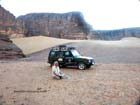 Raymond, navigator
Raymond, navigator |

Akakus plateau |
 Small car, big landscape
Small car, big landscape |
|
|
Our Touareg guide turned suddenly into the dunes and we
entered the sand sea through a narrow sandy corridor. A
little further we drive some way up a steep dune and stop
on the crest to survey the scene. There before us lies a
picture-book desert with dunes stretching off into the horizon.
One graceful sweep after another fill the view and the low
evening sun casts long shadows and highlights the sweeping
crests. We drop down into a dune encircled amphitheatre,
warm, silent and secluded in a world of our own. We pitch
our camp for the night.
Fred and I set up a dune-jump photograph next morning and
we each roared up a tall dune, balanced briefly on the crest
and drove gently over, all under full control. “You
don’t often see dune-driving as good as that...!”
we joked. |
|
|
 |
|
Starting
a dune run |
Mounting
the crest |
Controlled
descent |
Levelling
out |
|
Tuesday 8th November
Wadi Mathendous
Today we drove some 230km on mainly flat desert of varying
comfort. Some was fast and firm, some was soft and slow,
and all was incredibly dusty. The dust here is unbelievable
– it permeates every crack and crevice, billows up
all around us so we lose sight of the next car completely.
We were crossing a very large wide, flat desert devoid of
any landmark. We had lunch in the open desert under a baking
sun. The ‘Kitmax’ parasol gave Raymond and I
enviable creature-comfort, while the rest had to grovel
in the shadow of their cars under a near-vertical sun.
In the afternoon we crossed a tortuous plateau with big
sharp rocks strewn everywhere. This was Wadi Bajus, and
the landscape was hostile, sterile and lunar. There was
no way to avoid the rocks; we just drove slowly as the 4
x 4 traction coped with the terrain. |
|
|
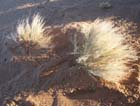 |
|
|
|
|
|
|
Rock-strewn piste |
Berber shelter |
The 'Kitmax'
parasol |
Wadi Mathendous |
|
Eventually we arrived at Mathendous, a tiny watery wadi
with bushes, reeds and yellow wild flowers. Bordering the
wadi was a wealth of rupestres, Neolithic engravings of
grazing animals dating to over 5,000 years old. We spent
some time here marvelling at this historic, water-filled
oasis bound on all sides by open desert.
We left at 4pm, crossed the stony ground and regained the
smoother plateau beyond. After an hours driving we found
another dune ridge to explore for our evening camp. We stopped
to gather firewood in a shallow fertile depression and found,
after some sandy dune slithering, another beautifully isolated
valley surrounded by great sweeping dunes stretching off
into the sunset.
Our combined group numbered 8 cars and crew, and we all
got together for a riotous aperitif around the campfire.
After dinner we assembled again for a Calvados in the moonlight. |
|
|
 Desert skies
Desert skies |
 |
|
|
Wednesday 9th November
Germa and Garamantes
We left at a leisurely 9am and drove down a long and very
dusty plain, still heading due East. We arrived at the
little town of Germa, refuelled all our seriously depleted
fuel tanks then visited the museum and the old ruined
Garamantes city. The inventive Garamantes people occupied
the Libyan desert from around 1,000BC to 400 AD and are
noted for their advanced agricultural and irrigation skills.
They built hundred of wells and underground irrigation
channels thoughout this part of the Libyan desert. Most
of their installations exist to this day.
|
|
|
|
| |
|
|
|
|
Isabelle
et Pascale |
1400
year-old mud wall |
Garamantes
town |
Old
market place |
We are now installed in the second campsite of this
trip and meet up with the other groups who spent the last
3 days in the dunes. We reunite with Thierry and Fabrice,
and Josiane and Patrick arrive too. Tomorrow we all return
to the dunes again. |
|
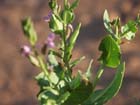 |
|
|
|
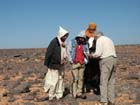 Raymond and Touareg
Raymond and Touareg |
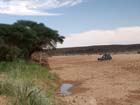
Wet sands in the Wadi |
|
|
| |
Thursday 10th November
Desert Lakes and Palmeraie Camping
The campsite was at the foot of a great sweep of dunes
with a broad saddle between the higher reaches. This was
our intended route. We drove up into this boundless tract
where the going was soft and a combination of speed and
traction was essential. As we went higher and higher the
view became more exciting. Great swirls of soft sand were
blown into delicate shapes by the wind. We picked our
way up dunes, around dunes and over dunes. The driving
was tough on the engine, but fairly easy on the tyres…..until
I got a puncture, a most unlikely event in this environment.
Jacking up a car on soft sand is not easy and I used the
high-lift jack. I mounted it on a sand ladder which disappeared
completely from view and had to be dug out. The tyre was
soon changed and we continued.
We arrived at the first lake-in-the-sand, an extraordinary
desert surprise in shimmering blue, a palm fringed lake
bordered by huge dunes. We drove around it, with difficulty,
before proceeding to the next lake 3km away. This one
was bigger and the still surface reflected the palms and
the dunes in the water.
There was a small village here, once a thriving and self
sufficient community, but now long abandoned and only
a handful of adventurous Touareg traders come here to
sell artefacts to passing travellers. They were accompanied
by the ubiquitous 'moula moula' bird which is found in
all parts of the North African desert. Moula is the Touareg
name for a desert sparrow. The bird is the mascot of the
Touareg people.
After a brief stop by yet another desert lake (there are
several in this sand-locked area) we left to drive into
the higher reaches of the northern dune crossing. We mounted
a very long high slope, and then another. The going was
firm and we made good progress. |
| |
|
|
|
| |
|
|
|
|
Lakes
in the sands |
Tanya
at lake site |
Touareg
traders |
'Moula' bird on palms |
|
We reached a high ridge where several cars had stopped.
We soon saw why, this was the beginning of a serious drop
– over 75ft down, with a dangerous hollow in the
middle and another 75ft drop below. All followed by a
steep, sandy ascent to a small level area half way up
the other side of the escarpment.
We set off down the incline in second gear, to give some
measure of control over our downward charge. The descent
went well, we crossed the gully and both gasped at the
second drop which was even steeper and longer than the
first. The car slithered a little on the soft sand but
stays on course. Near the end I changed up a gear, bottom
out and left the slope at full speed to gain momentum
for the steep ascent.
| |
|
|
|
| |
|
|
|
|
Lake
in the desert |
Palms
near the lakes |
Fred
& Kit in sands |
The
'Kitmax' parasol |
We roared up to the clearing to join the others there,
to be greeted by a round of applause! So flattering and
so charming….. Unfortunately our luck lost us there,
I had another puncture. Two punctures in two hours, and
on sand too. We jacked up again with the help of an airbag
jack (which was only partly successful), and my trusty
hi-lift jack.
I fitted my second and last spare wheel, an old military
tyre that failed to match the others for sidewall flexibility
and gave much reduced grip at low pressure… and
none at high. The problem was to haunt me all afternoon
as my previously good sand performance was now greatly
impaired, and the quality of the sand was deteriorating
rapidly. |
|
 Dwarfed by huge dunes
Dwarfed by huge dunes |
|
|
Dunes have a firm windward side and a very soft “slip”
side. The prevailing wind dictates the general direction
from (NE to SW in the Sahara) and the dunes sometimes form
easily driveable corridors in between.
Where it all goes wrong is where one dune formation meets
another, and a great sandy turbulence develops, with firm
sand and soft sand sharing the same slope. And this was
the surface we encountered now.
We suffered many more hold ups and reached a mighty climb
bordered by very soft sand. Several cars had failed already,
but it was the only route out of this dune valley. Frederic
and Alain took a long fast charge and made it almost to
the top. Suddenly they hit a soft patch and slewed sideways
on the steep slope. We both gasped in horror as the inevitable
appeared unavoidable. We had already had one Land Rover
roll over on a similar ascent. The Nissan slithered and
stopped and Frederic was able to engage reverse gear quickly
and regain his alignment. He reversed at full speed half
a kilometre, gained some firmer higher ground and tried
again. This time he made it, a great piece of driving. I
drove around on my three good tyres trying to gain height,
and could not persuade the car to gain either speed or momentum.
Eventually Laurent took a run and we made it to the top,
amid cheers from my companions. |
We were off again across a wilderness of sand, some firm,
some soft and some just undriveable. We came over the brow
of a dune to find a Land Rover deeply embedded in a bottomless
tract, and we had to push, pull, dig, winch and tow before
we released him. He shouldn’t have been there alone…
It all took a long time and we still had a long way to go.
Our three cars were alone on an endless plain of alternately
hard and soft sand.
We mounted a classic dune crest with a very sharp profile
and I bottomed out and stuck, finely balanced with all four
wheels off the ground. It looked very comic but took a lot
of work to dig out under the vehicle and get at least two
wheels to grip. Our friends in that great wide Hummer Hum-vee
gave the ridge a try and did exactly what I did. So now
there were two ridge-bound vehicles clawing for a grip.
The 4.5 ton Hummer doesn’t respond to a push, so we
called up Tanya and Patric’s Land Rover and winched
him over. By then my wheels were engaged and the Hummer
and I roared down the steep slope together. |
|
 Hum-Vee Hummer
Hum-Vee Hummer |
|
|
With our many delays today it was now late and we would
have to drive fast to make our rendezvous with the others.
At 6.00pm, nearly dark and with only 3km to go, I sustained
unbelievably, the third puncture of the day. Now I had no
spare wheels left and the situation was serious. But Frederic
saved the day with a bombe, a tyre inflating canister with
which he repaired this morning’s tyre. We changed
the wheel, experts now, and were back on the piste in 10
minutes. We rolled into our rendezvous very late, with full
lights, and set up camp. We were in a palmeraie, but all
we could see was the dark silhouettes of the palms again
the night sky.
This had been the longest, most dangerous and fatiguing
day of the trip. Two Nissans out of service, 1 rolled Land
Rover, a broken Toyota and a blown Toyota Turbo. Our recovery
vehicle had much to do…. |
| |
|
|
|
Desert
dusk |
Wadi Chaati
camp |
Desert
dawn |
|
Friday 11th November
Rubta hotel
We left camp early as sunrise illuminated our beautiful
palmeraie. The tall palms rose from the sand and spouted
shady fronds high above us. We drove down a soft sandy wadi
for some miles. At one point a dune encroached and blocked
the way. There was a car already stuck there and we had
to help him out. I had no appetite for de-pressuring tyres
so soon after reinflating them, so I attacked the obstruction
at considerable speed…..and became briefly airborne!
The landing was softened by the sandy descent, but this
was the manoeuvre that destroyed the Toyota the day before.
At last we hit the North-bound Tripoli road, and our desert
trip was over. 600km later we pulled in, much fatigued,
to a barely adequate Rhabta Hotel in Gharyan. We ordered
a gassy, lukewarm, alcohol-free beer in the one noisy bar,
and wished to be back in those silent, dune-encircled campsites
we had so enjoyed in the previous weeks. |
| |
|
|
Farewell
dinner on boat |
Last
night in the desert |
Marseille
revisited |
|
|
Saturday 12th November
Kairouan Kasba Hotel
Another early start, then a 3-hour wait at the Tunisian
border followed by a 655km drive to Kairouan. We were
booked in at a splendid mud-walled Kasbah hotel, had a
grand dinner and assembled later for an end-of trip presentation
by Laurent.
I sat with Frederic, Alain, Patrick and Josiane. As each
team was called up to receive a souvenir plaque, everyone
in their group clapped. A great bond of friendship had
been made by Raymond and I with our fellow travellers
and I long to travel with them all again.
|
|
Mid-November,
back home and unpacking the
Land Rover Discovery |
|
ŠKit Constable Maxwell
Libya Expedition part 1- click here
|
|